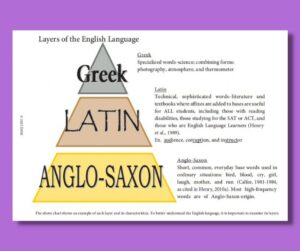Greek
Greek bases tend to be found in our math and science terms. Some Greek bases can stand alone (e.g., phone), but they often combine (e.g., photo + graph = photograph) — these are called combining forms and resemble compound words. Other examples include microscope, microphone, hydrophobia, and thermometer. When teaching Greek bases to students, focus on those that are most applicable; avoid rare, highly specialized Greek vocabulary (e.g., advanced medical terminology).

Greek bases tend to be nouns. Many of them can be recognized by spelling markers, as they have some unusual letter-sound representations. Listed below are some common orthographic markers for Greek words:
- ph – /f/ (e.g., telephone, grapheme)
- rh – /r/ (e.g., rhinoceros, rhythm)
- ch – /k/ (e.g., chemist, Christmas)
- ps – /s/ (e.g., psychology, psychiatrist)
- y – /ĭ/ or /ī/ (e.g., rhythm, hydrogen)
As with all new morphemes, remember to make learning as multisensory as possible. Consider using pictures or videos to introduce examples of words with Greek bases, and continue to have students create a morpheme card each time a new morpheme is introduced. Provide numerous opportunities for students to see and use the bases in context. See the “Morphology” and “Masters” sections of IMSE’s Morphology Plus Training Manual for more information and ideas for teaching Greek.
